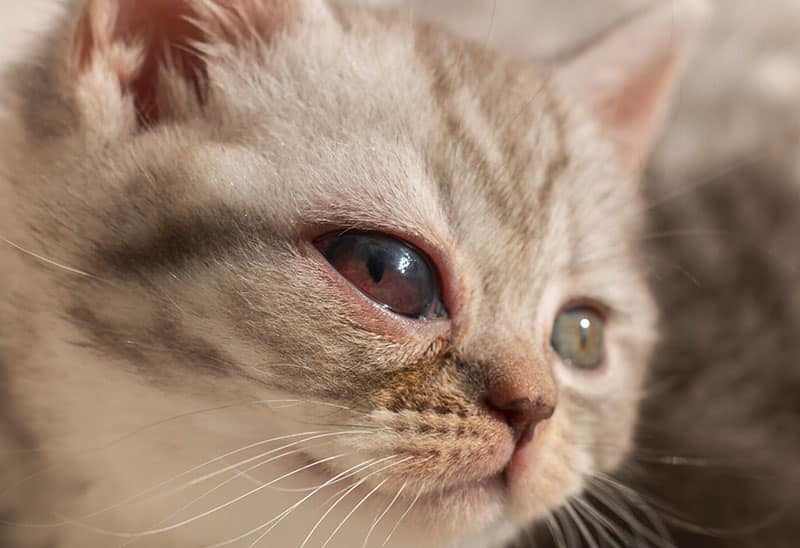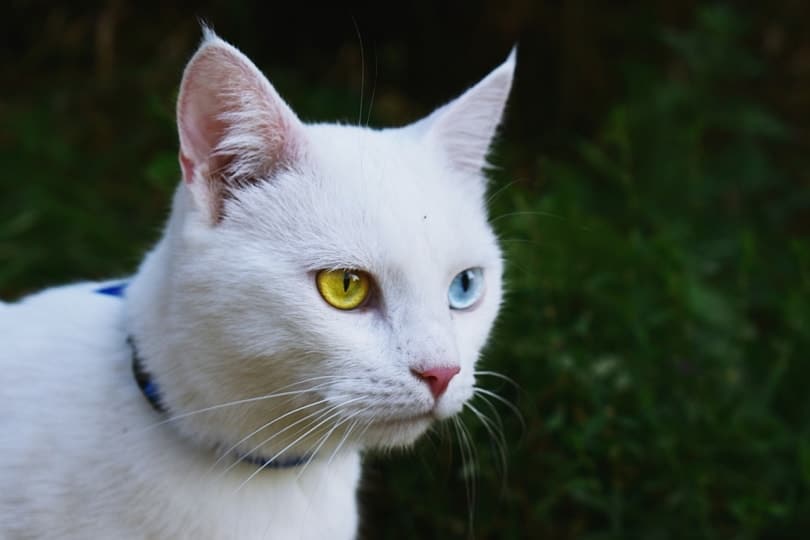As sight develops, cat’s eyes often begin to change, and take on a range of different colors, from browns and yellows to greens, oranges and ambers. This change will likely begin somewhere between three to eight weeks of age. It’ll be complete by the time your kitten turns three months old.
Why Do Cat Eyes Dilate?
Because of their special ability to control the size of their pupils, cats can modify how much light enters their eyes. A cat’s reflexive reaction to environmental changes is to dilate their pupils.
A cat’s pupils will constrict and get smaller in bright light to lessen the amount of light entering the eye. On the other hand, when there is little light, their pupils will enlarge or dilate to let in more light and enhance their vision.
Furthermore, a cat’s pupils can dilate in reaction to both physical and emotional stimuli, including pain, fear, or excitement. Cats’ pupils dilate in response to being aroused or feeling threatened, enabling them to process more visual information and respond appropriately.
In conclusion, cats’ pupils enlarge in reaction to environmental changes as well as to psychological and physical stimuli. This enables them to keep their best vision and react appropriately to different situations.
What Determines Eye Colors in Cats?
Let’s first discuss what determines eye colors in general before delving into what causes abnormal eye colors in cats.
The amount of pigment in the iris determines the color of a cat’s eyes. Melanocytes are the cells that produce and store melanin, which is the pigment that determines an animal’s or human’s skin, hair, and eye color. A cat’s eye color is largely determined by the amount of melanin in the iris; the more melanin there is, the darker the eye color.
However, blue eyes don’t have any pigment in them. Some of the longer wavelengths of incoming light are scattered and absorbed by iris fibers. As a result, the eyes appear blue and more blue light emerges.
What Causes Abnormal Eye Colors in Cats?
Cat eye color is determined by a few factors, but what causes abnormal colors? Let’s investigate.
Due to an inability to adequately drain the fluid produced inside the eye, glaucoma causes an increase in intraocular pressure, or the pressure inside the eye. Glaucoma is a dangerous illness that can cause blindness. The color of the eyes may shift and take on a cloudy, milky appearance. In addition to producing a watery discharge and irregularly shaped pupils, the condition can cause eye pain and cause a color shift, usually turning the eyes blue. To prevent blindness and irreversible damage to the affected eye, this condition calls for an urgent visit to the veterinarian.
An inflammation of the uvea, the internal vascular layer of the eye, is known as uveitis. Trauma, a tumor, various infections, or an immune-mediated process can all cause uveitis. Uveitis is another dangerous condition that needs to be properly treated because, if ignored, it can result in issues that last a lifetime. Signs of uveitis are numerous and not specific to uveitis. The iris may appear reddish or darkened, the eye usually appears cloudy, there is frequently a watery or mucousy discharge, and the white of the eye may appear red and swollen. Usually, the cat will squint or paw at the affected eye, which results in decreased vision, though if only one eye is affected, this may not be noticeable.

Heterochromia involves differences in iris coloration and is determined by genetics. There are a few types:
- In a cat with heterochromia iridum, or “complete” heterochromia, one eye will be darker than the other due to excess melanin. Usually, one eye is blue and the other is green, but occasionally, the other eye may be brown or yellow. This condition is often referred to as “odd eyes”.
- Heterochromia iridis, also known as “segmental” heterochromia: This condition causes the colors of an iris to differ in different areas.
- Central heterochromia: This condition also affects one eye’s two distinct colors. One emerges from the pupil and mixes in a spiky pattern with the other one.

FAQ
Is it normal for my cats eyes to change color?
What is the rarest eye color for cats?
What age do cats eyes turn from blue to green?
Why did one of my cat’s eyes turn brown?